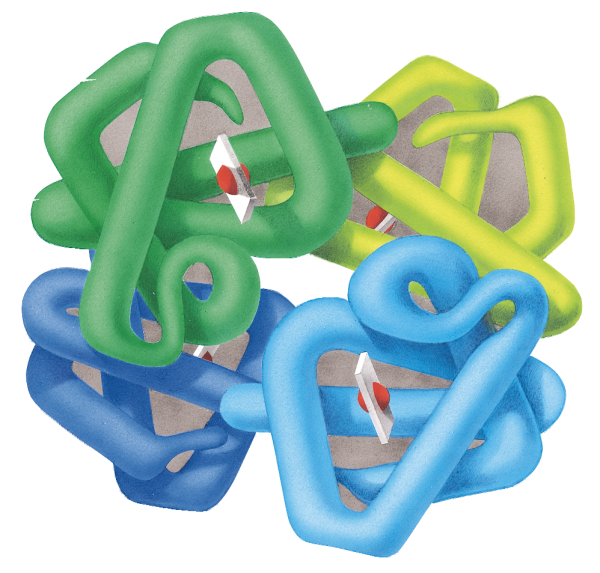Hemoglobin (1000)
Unknown Year, Unknown Dimensions

Geis uses four colors to depict the hemoglobin tetramer structure. The heme groups are shown as white rectangular prisms. A red sphere is in the middle of each of these, representing an iron ion that allows capture of oxygen molecules. Hemoglobin is essential in transporting oxygen in vertebrates.
Used with permission from the Howard Hughes Medical Institute (www.hhmi.org). All rights reserved.

Related PDB Entry: 2HHB
Experimental Structure Citation
G. Fermi, M.F. Perutz, B. Shaanan, R. Fourme. (1984). The crystal structure of human deoxyhaemoglobin at 1.74 Å resolution, Journal of Molecular Biology, 175, 159-174.
About Hemoglobin
Hemoglobin is a protein found in the red blood cells of all vertebrates that is responsible for the transport of oxygen. The high iron concentration in the molecule gives blood its red color. Hemoglobin has a tetrameric quaternary structure of two alpha and two beta chains, each containing a ring-shaped heme group, giving the overall appearance of having four myoglobins combined into one structure. These heme groups use their central iron atom to bind oxygen, and, in this way, blood carries oxygen from the respiratory organs throughout the body. While hemoglobin is best known for its role in vertebrate respiration, it is also found in some invertebrates, fungi, and plants, where it transports other gases like carbon monoxide, nitric oxide, and hydrogen sulfide.
Text References
Dutta, S. & Goodsell, D. (2003). Molecule of the Month: Hemoglobin. DOI: 10.2210/rcsb_pdb/mom_2003_5
Initial Structure Determination Reference
Perutz, M. F., Rossmann, M. G., Cullis, A. F., Muirhead, H., & Will, G. (1960). Structure of hæmoglobin: a three-dimensional Fourier synthesis at 5.5-Å. resolution, obtained by X-ray analysis. Nature, 185, 416-422.




